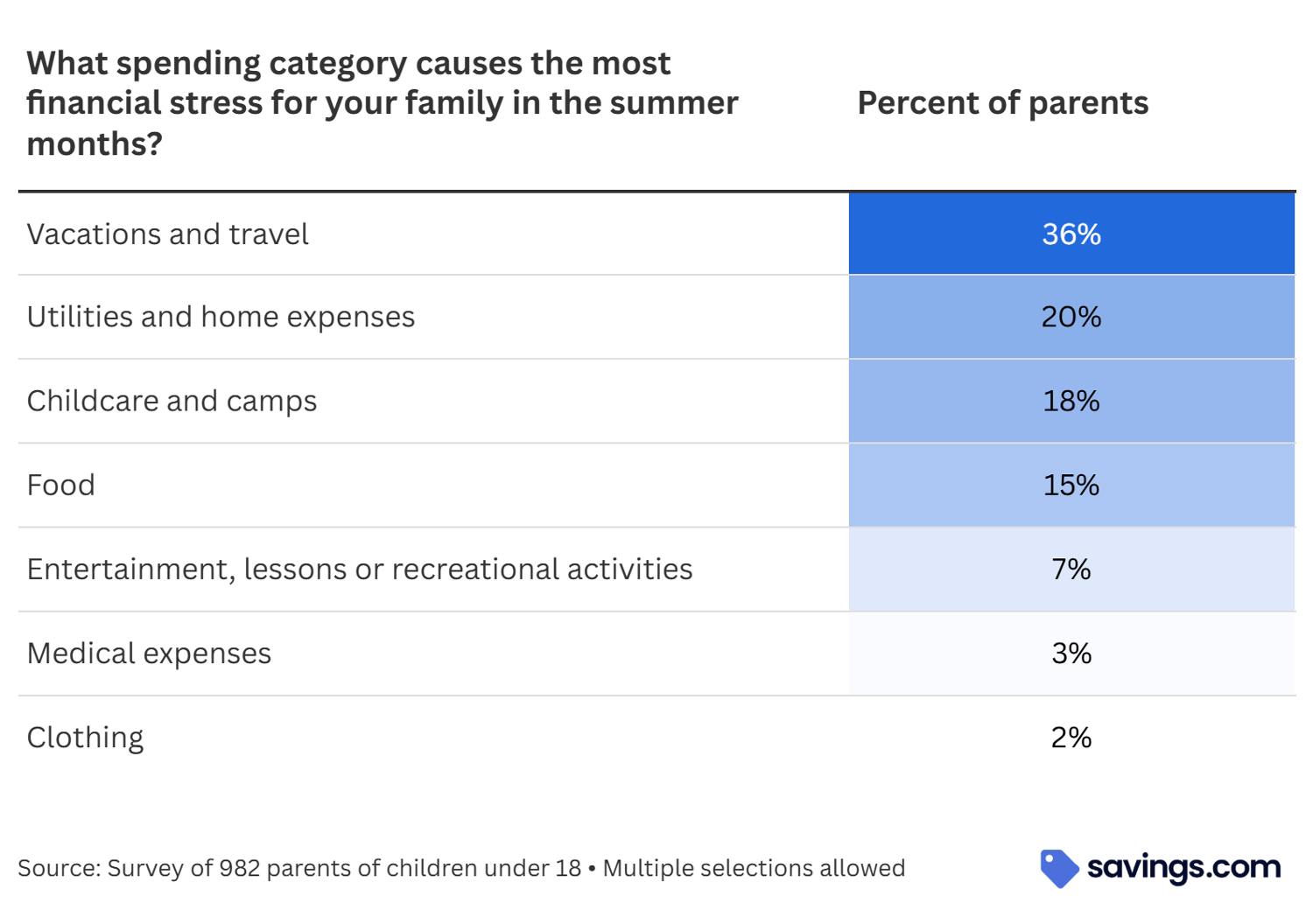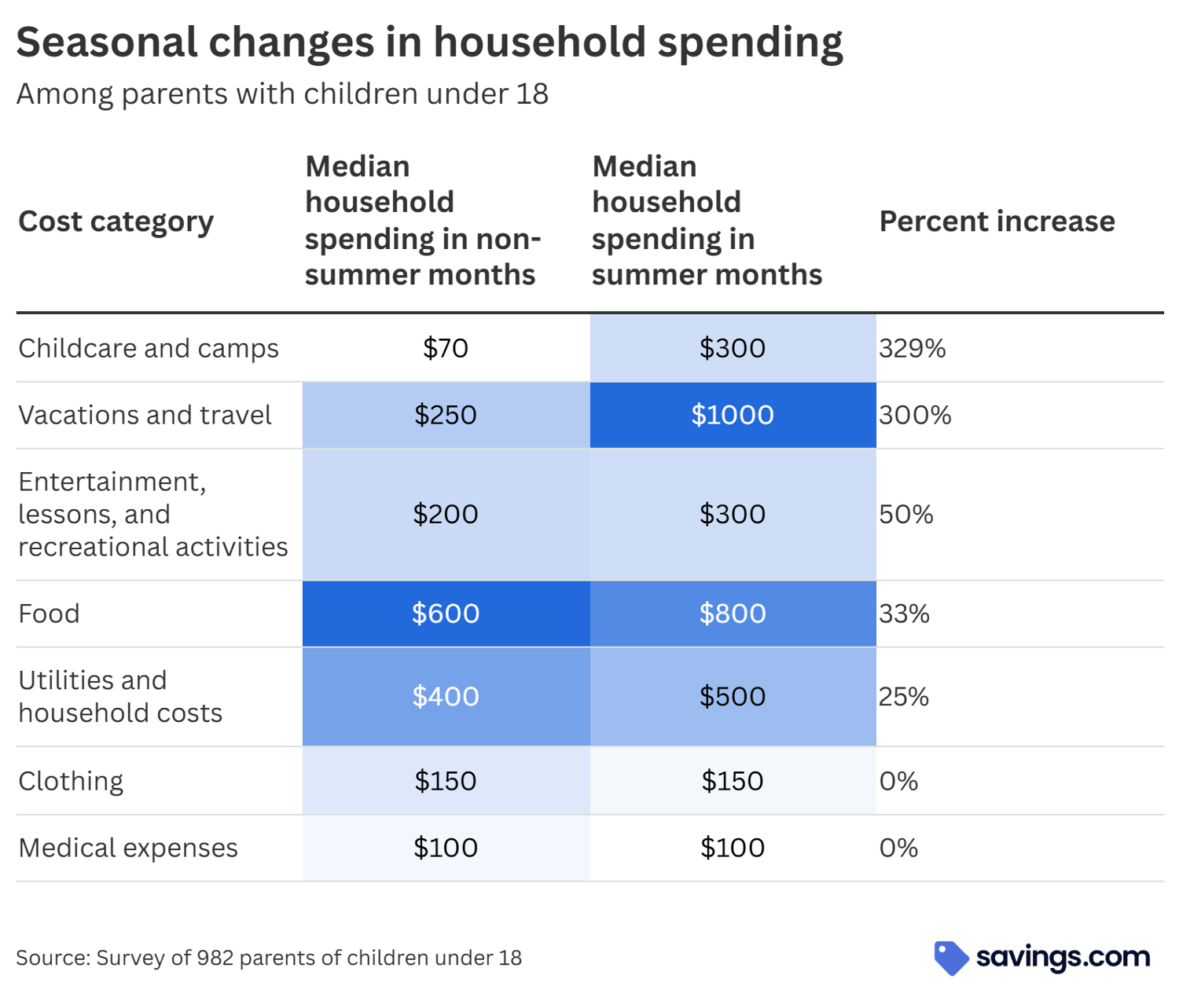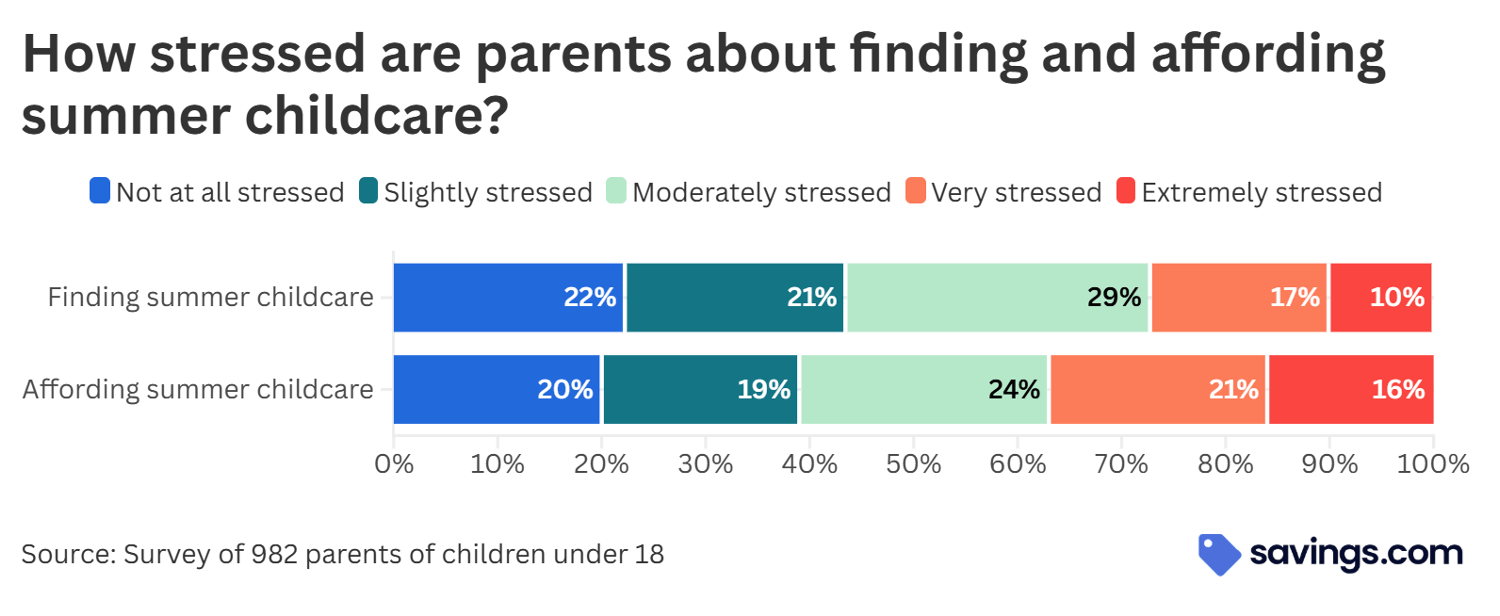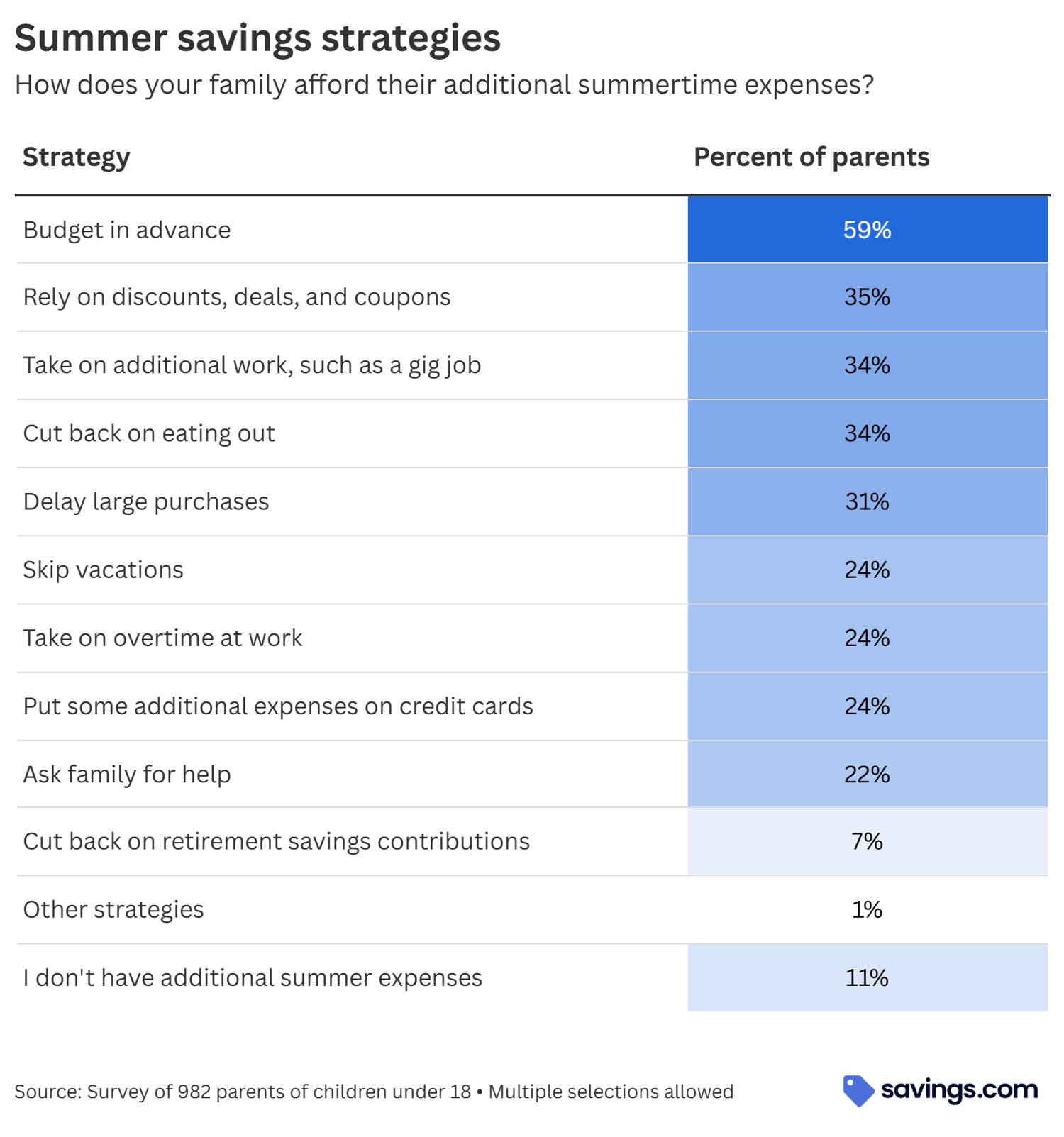
Last Updated: April 24, 2025
Summer is the most expensive season for many U.S. parents, with monthly childcare spending increasing over 300% for the typical family.
For millions of parents across the U.S., the final bell of the school year signals the start of a season of spending — and that’s before factoring in this year’s expected tariff-induced price increases on everything from toys to strollers.
We wanted to understand how family spending changes over summer break — and how parents attempt to budget for a fun-filled season with their children. So, we gathered insights from nearly 1,000 U.S. parents. Here are some highlights from our research:
- Over one in three parents (35%) say summer is the most expensive season — second only to winter and well ahead of fall and spring.
- Childcare costs for typical families surge over 300% during the summer months, from $70 in non-summer months to $300/month during summer break, creating financial and logistical stress.
- Finding childcare is often just as stressful as paying for it: While 37% of parents say affording summer childcare causes significant stress, 27% are also worried about simply finding available care. Many parents cobble together childcare plans that involve relatives, costly camps or sitters, and themselves.
- Travel is the most considerable summer expense and stressor: Parents report spending a median of $1,000/month on vacations during the summer.
- Parents use creative strategies to make ends meet in the summer: Most parents budget in advance (59%), but many also take on extra work (34%), use coupons (35%), or cut back on luxuries like dining out (34%). Still, nearly a quarter of parents use credit cards or delay major purchases to get through the season.
More than 1 in 3 parents say summer is their most expensive season
While most parents said winter was the most expensive time of year, a significant percentage said they spend more during summer than any other season. While winter could be costly for many due to the travel, hosting, and gift-giving associated with holidays like Hanukkah and Christmas, what about summer strains so many families financially?
For many families, a complex combination of factors drives costs up in the summer. “I have a 7-year-old who really isn't ready to be home alone yet," said one of the parents in our study. “Unfortunately, his grandfather passed away, so we have to rely on babysitters and other expensive means when necessary. To top that off, we live in Arizona, where summers are often 115 degrees, so the electric bill also shoots to $500+."
Parents in our study were most likely to identify vacation and travel costs as the most financially stressful. While summer vacations are often fun and relaxing for kids, they can also be costly for parents. Nearly one in five parents (36 percent) said vacations and travel cause their family the most significant financial strain in the summertime, far ahead of other spending categories, including utilities and home expenses, and childcare or summer camps.

Typical parents spend $1,000 per month on travel in summer, while childcare costs also balloon
For the typical family in our study, travel expenses exploded in the summertime. The median amount spent per family on travel in the summer months is $1,000, four times what families spend on travel during non-summer months.
Many observers expect travel costs to spike this summer, particularly due to global economic unpredictability, as with products like toys and other consumer goods. Indeed, according to one report, airlines predict that travelers will scale back their plans amid rising fares. And, of course, airfare is not the only major expense related to travel; hotels, dining, attractions, and souvenirs can all quickly add up.

Childcare expenses increase the most during the summer. Parents in our study anticipated spending $300 monthly on summer childcare, compared to roughly $70 during the school year—a 300% increase. This category encompasses nannies, babysitters, other caregivers, and summer camps, which often come with substantial enrollment fees.
During the summer months, parents in our study experienced higher expenses across different categories. Recreational costs like lessons or entertainment jumped by 50 percent for the average family. Meanwhile, food spending increased by 33 percent, likely because children eat meals at home instead of at school cafeterias. Utility bills also rise, due to increased air conditioning expenses and greater use of lights and electronics when children are at home rather than school.
Finding and affording summer childcare stresses parents out
In 67 percent of households with two married adults, both parents work, according to the U.S. Bureau of Labor Statistics data. Since the typical U.S. worker can’t simply take the whole summer off to provide childcare, tending to kids when they’re out of school often falls to others, which sets off a stressful scramble for parents.
More than a quarter of parents (27 percent) told us they were stressed out about simply being able to find childcare for their kids during summer break, let alone whether they could afford it, which 37 percent said made them “very" or “extremely" stressed.
Even parents with high incomes felt squeezed by summer childcare costs. “The total household earnings of $177,000 do not protect us completely from summer spending pressures," said one of our study participants. “Electricity to operate air conditioners and the childcare fees when my two-year-old stops attending daycare drive up our costs. Gas prices tend to increase due to traveling on the roads frequently."

The high cost of childcare is not the only factor that makes it hard to source. There simply aren’t enough childcare providers in many places, which has prompted national conversations about increasing childcare programs and incentivizing providers. A 2021 report by the Treasury Department found that a lack of funding was a primary driver of the childcare shortage.
About half (55 percent) of parents we talked to said they or their partner provides childcare while kids aren’t in school. This may work for parents who don’t work full time or from home, but other childcare options are necessary for most parents.

Aside from parents, other family members are the most common source of childcare (48 percent), followed by summer camps (22 percent) and sitters or nannies (18 percent). Some childcare options may be cheap or low-cost, but sitters certainly aren’t. A recent Care.com survey found that a family can expect to spend as much as $5,532 for a summer’s worth of babysitting.
Speaking of expensive childcare, the median cost of summer camps that the parents in our survey considered was $1,200, rising to $24,000 on the high end.
How parents cope with scorching summer costs
Parents will use various strategies this summer to offset their higher seasonal spending. While a majority (59 percent) budget for the higher costs in advance, many will use deals, discounts, and coupons to save some money (35 percent). Others will take on additional work (34 percent) or ask for overtime (24 percent) to beef up their income in the summer months.

It was common among parents in our study to cut back on luxuries like dining out, delaying large purchases, or skipping vacations. Some parents rely on credit cards to help cover shortfalls, while a small percentage cut back on retirement savings contributions—two strategies that may have unfortunate long-term implications.
Summer Savings Tips for Parents
Our data shows that parents need all the help they can get to ensure their summer isn’t financially ruinous. Parents can stretch their dollars further with some upfront research and budgeting throughout the year for summer fun. Here are some of our favorite deals for savings on travel, clothes, and other summer essentials:
- Consider travel packages. Booking flights and accommodations as packages through the same site can often unlock significant discounts. Trip.com offers up to $70 off first bookings, Expedia provides 25 percent off hotels in popular destinations, and JetBlue Vacations gives $50 off flight and hotel bookings of $2,000 or more.
- Book in advance for special discounts. Sometimes, it pays to plan ahead! Making reservations weeks or months in advance typically secures lower rates. Right now, Great Wolf Lodge is rewarding early planners with 40 percent savings on their bookings. On the other hand, if your family has flexibility and a sense of adventure, some travel sites offer deals for last-minute reservations. Right now, Booking.com is offering 20 percent discounts on last-minute “Getaway Deals."
- Stock up during seasonal sales. Retailers specializing in travel gear and children's clothing frequently run seasonal sales, with discounts on essential summer items, including swimsuits, shorts, and luggage. Eagle Creek offers 20 percent off full-priced items like suitcases and duffel bags, while Old Navy has 50 percent off thousands of baby and kids' summer items, including select swimsuits.
Methodology
In March 2025, we surveyed 982 American adults with at least one child under 18. Respondents were 50 percent female and 50 percent male, and their ages ranged from 19 to 74, with a median age of 38.
